#black lechwe
Text
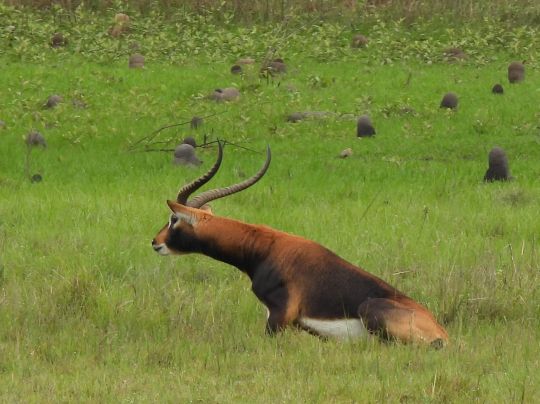
Black lechwe Kobus smithemani
Observed by nicovr, CC BY-NC
85 notes
·
View notes
Text
Name: Mr. Kade Delany
Color: Blue #3944bc
Symbol: anemone
Strife Specibus: makeupkind
Handle: therapeuticGenethlialogist
Animal: lechwe
Pronouns: ey/em
Age: 43
Birthday: 52th day of the year
Sexuality: gay
Interests: jet-skiing and mineral collecting
Dream Moon: dual dreamer
Classpect: Page of Light
Land: Land of Frogs and Pain, a repulsive place, with frightened Flatback Sea Turtle consorts. It is a place full of mountains like dragon's talons and a black desert. Hyperion is in pain.
Instrument: cervelat
0 notes
Text
THE BEST THINGS TO DO IN LUSAKA, ZAMBIA
Are you traveling to Lusaka, Zambia? Here are some interesting ways to explore Lusaka's history, tourism, and daily life. and explore the top attractions, including the Lusaka National Museum, Kabwata Cultural Centre, and Arcades Shopping Mall. From cultural experiences to modern entertainment, this city has something for every traveler.
Lusaka is a rapidly developing city that offers an authentic African experience. Spending a few days in the capital is an excellent way to immerse yourself in Zambian culture and local life. From the city's genuine African ambiance to its cosmopolitan population, quality restaurants, and luxurious accommodations, there are plenty of reasons to stay for a night or two. Here are the best places to visit in Lusaka, Zambia, and plan your adventure now.
Lusaka National Park is a must-see
Lusaka National Park is the newest and smallest national park in Zambia, located just 30 kilometers away from the city. Despite being situated in a populated area, there are over 1,000 species within the park, including white rhino, giraffe, eland, hartebeest, zebra, sable, kudu, blue wildebeest, waterbuck, black lechwe, impala, puku, bushbuck, reedbuck, warthog, pangolin, and axis deer. These animals roam freely in the park's diverse habitat, which includes forests, lakes, rivers, and waterfalls. The park offers a variety of activities such as camping, walking safaris, bicycle trails, game viewing, boating, photography, bird watching, and picnics.
Experience a panoramic view of Zambia by visiting Nembo Scenic Park
Nembo Scenic Park is a miniature replica of the map of Zambia that covers an area of 47,000 square meters. You can enjoy a bird's-eye view of the country without having to take a flight. The park is situated approximately 11 kilometers from the city center, making it an ideal spot to take a leisurely walk with your family. You can also enjoy the serene beauty of the park's lakes and waterfalls.
Shopping at Arcades Mall
Arcades Shopping Centre in Lusaka offers a variety of clothing and jewelry stores, eateries, and entertainment for the whole family. The center has fast food chains, sit-down restaurants, a nightclub, a casino, and a cinema complex. Arcades also have banking facilities, a Bureau de Change, a Spar supermarket, Mica Hardware, clothing stores, and gadget shops.
Pakati Market - A great place for gifts and crafts
One of the best weekend markets in Lusaka is the Pakati Sunday Market. It offers a wide range of products, including jewellery and home decor, in a convenient location. The Pakati Sunday Market is an excellent opportunity to discover the creativity of Zambia.
Kabwata Cultural Village, part of Lusaka's history
Visit Kabwata Cultural Village in Lusaka for traditional Zambian artifacts and hand-crafted gifts. Over 80 resident artists come from all nine provinces of Zambia, offering a wide range of woodcarvers, basket weavers, and more. You can watch them create wood figurines, textiles, beads, and masks. Meet the skilled craftsmen who create beautiful artifacts right in front of you. You can buy these unique pieces directly from the creators themselves. While you're here, you can enjoy a delicious lunch at the traditional restaurant in the village. If you're visiting the region during winter, plan your Sunday around watching local dancers perform. It's a great way to spice up your dining experience!
Explore the Chaminuka Game Reserve
Chaminuka Game Reserve in Lusaka, Zambia is a wildlife destination that offers visitors a range of activities such as game drives, bird watching, bush dinners, hot air balloon rides, night game drives, cycling, fishing, boat trips, and photography. This reserve boasts over 300 bird species and 72 Zambian species of mammals and reptiles, an opportunity to spot various animals such as elephants, zebras, lions, and more. It is a perfect destination for nature lovers and wildlife enthusiasts
Check out Zambia's National Museum
Explore Zambia's intriguing history by visiting the National Museum. This cultural history museum showcases Zambia's journey through four main sections: ethnography, traditional ritual, history, and contemporary art. The 'Freedom State' statue, depicting a man breaking his chains, symbolizes the nation's struggle for independence. The National Museum offers a lot to see and learn about Zambia's culture and history, and it's well-maintained to provide the best experience for visitors. It's a fascinating and educational day out for the entire family.
The Lilayi Elephant Nursery
The Lilayi Elephant Nursery is a heartwarming place where you can watch orphaned baby elephants being fed and play with each other. It was established in 2012 with a noble mission to save elephant calves from poachers and provide them with a safe and caring environment. However, you should note that due to the trauma they've experienced, you cannot pet the baby elephants. Moreover, to ensure that they can be reintroduced back into the wild, they're kept away from close interaction with humans. If you're interested in learning more about the project, you can arrive before noon and listen to one of the staff members explain the organization's work. This is an excellent opportunity for those who adore baby elephants and want to support the organization's outstanding efforts.
Visit Paray's Game Ranch to observe exotic wildlife.
Parays Game Ranch offers an exciting opportunity to get up close with Zambia's wildlife. You can explore the park at your own pace on a 4x4 and see various animals such as zebras and wild boars. The white lions are the park's main attraction and are free to roam in their well-maintained area. After observing the animals, you can enjoy a delicious barbecue of bush meat. Paray's Game Ranch is an ideal destination for a fun family day out.
The Victoria Falls
When considering a visit to Zambia, a trip to Victoria Falls should be considered a top priority. Known as ‘Mosi-oa-Tunya’, or ‘the Smoke that Thunders’, these falls are a stunning spectacle of natural beauty, and one of Africa’s most notable attractions, as well as being one of the Seven Natural Wonders of the World. Located on the Zambezi River, Victoria Falls serves as the border between Zambia and Zimbabwe. They are the only waterfall in the world that spans over one kilometer in width and drops over 100 meters, making them the largest curtain of falling water in the world. Despite being a full-day excursion from Lusaka, the experience of visiting Victoria Falls is an unparalleled highlight of any Zambian adventure and should not be missed.
Visit Kalimba Reptile Park
Visit Kalimba Reptile Park to see giant Nile crocodiles, indigenous snakes, tortoises, and other reptiles. You can also spot the rare and elusive slender-nosed crocodile. Take a guided tour to learn about each type of reptile. It's a great day out for families. Located 20 km northeast of Lusaka, the park also has a farm shop with affordable products
Visit Kamwala Market
Visiting Kamwala Market is one of the best things to do in Lusaka. It's a bustling local market where you can find almost anything, from food and electronics to clothes and even livestock. The market is quite extensive, so you can easily spend an hour exploring it. Trust me, there's a lot to see when visiting this place.
#Lusaka#Zambia#Vacation in Zambia#Vacation in Lusaka#Holiday in Lusaka#Holiday in Zambia#Vacation rentals in Zambia#Vacation rentals in Lusaka#accommodation in Zambia
0 notes
Photo
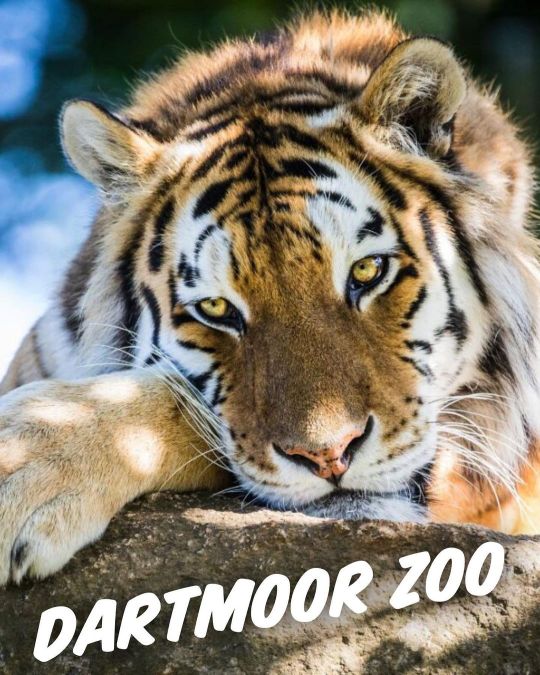
@dartmoorzoo has over 70 different animal species, including some endangered and critically endangered species. The zoo has a breeding programme with common marmosets, tapir, slender-tailed meerkats, Kafue lechwe, and wallaby. They also have Mammals Amur tiger, African lion, Jaguar, Carpathian lynx, Red-handed tamarin, Gelada, Iberian wolves, Asian short-clawed otters, Raccoon, Vervet monkeys, Common marmosets, Ring-tailed coati, Slender-tailed meerkats, tapir, capybara, Kafue lechwe, Grant's zebra, sugar gliders, lesser hedgehog tenrec, Parma wallabies, Bennett's wallabies, Reeves's muntjac, Fallow deer, domestic rabbits, raccoon dogs, reindeer, Azara's agouti, African pygmy goats and Cloud rat. Birds Ostrich, greater rhea, white-cheeked turaco, avocets, Indian runner ducks, Helmeted guinea fowl, white-naped crane, great horned owl, great grey owl, burrowing owl, European eagle owl, striated caracara, Himalayan Monal, and golden pheasant. Reptiles Red-tailed boa constrictor, royal python, corn snake, milk snake, Western hognose snake, blue spiky lizard, blue-tongued skink, bearded dragon, crested gecko, American alligators, electric blue gecko and yellow-headed day gecko. Amphibians African bullfrog, poison dart frog, golden Mantella frog, axolotl. Invertebrates Sun beetle, leaf insects, Mcklay's spectre, giant thorny stick insect, orange-headed cockroaches, Indian ornamental tarantula, Brazilian black tarantula, Chilean rose tarantula, tailless whip scorpion, and tiger land snails. https://www.dartmoorzoo.org.uk/ (at Dartmoor Zoological Park) https://www.instagram.com/p/Cp-9fbvrHJ0/?igshid=NGJjMDIxMWI=
0 notes
Text
Black Lechwe of Zambia: Conservation Efforts and Threats-3
The black lechwe of zambia is a species of swamp deer native to Zambia and Zimbabwe. It is considered one of the most endangered large mammals on Earth.
Why Is The Black Lechwe Endangered?
The Black Lechwe of zambia is a species of antelope native to the wetlands of Botswana, Zambia, and Namibia. Its population is sadly dwindling due to multiple threats, making it an endangered species. Human activities such as overgrazing, hunting, and land conversion for agricultural use are all major drivers of the decline in Black Lechwe numbers.
Overgrazing has lead to habitat destruction, reducing the food and shelter available to the species. Hunting has caused a decrease in the number of adults available to reproduce, leading to a decrease in population.
Finally, land conversion for agricultural use is another major factor in their decline, as it reduces the amount of suitable habitat available for Black Lechwe populations. Conservation efforts must be implemented in order to prevent further decline of this species, including creating protected areas and educating local communities on the importance of preserving the species.
Additionally, research needs to be conducted to understand more about the ecology of the Black Lechwe and its habitat requirements in order to better inform conservation efforts. If these steps are taken, then we may be able to reverse the decline in Black Lechwe populations before it is too late.
How Can We Help Save The Black Lechwe Of Zambia?

Unfortunately, the black lechwe population has been decreasing over the last few decades due to habitat loss, poaching, and illegal hunting.
As a result, it is important that we take action to help protect this species. One way to do this is to support conservation organizations that are working to protect and restore the black lechwe's habitat.
Additionally, it is important to educate people about the importance of this species and why it should be protected. Finally, conservationists are also advocating for stronger laws and regulations to help protect the black lechwe from illegal hunting and poaching. By taking these steps, we can help ensure that the black lechwe population does not continue to decline and can eventually be restored to its former numbers.
What Are The Threats To The Survival Of The Black Lechwe?
Its distinct black fur and long legs make it a unique animal, but its population is declining rapidly due to a variety of factors. Human activity is the primary threat to the Black Lechwe, from habitat destruction due to logging and farming to illegal hunting for their prized skins and meat.
Global warming is also contributing to their decline by causing a decrease in their wetland habitats, making them more vulnerable to predators. The introduction of invasive species such as the Nile Perch into their habitats has also been detrimental to their numbers. Furthermore, the increasing spread of diseases such as foot-and-mouth disease is causing havoc among the Black Lechwe population.
Conservation efforts are essential to ensure the survival of this species, including habitat preservation and protection from illegal hunting. It is also important to raise awareness of the threats faced by the Black Lechwe, so that more people can contribute to their conservation. With our help, this species can still have a chance of survival and continue to thrive in its native environment.
What Is Being Done To Save The Black Lechwe?

The International Union for Conservation of Nature (IUCN) has classified the Black Lechwe of zambia as Vulnerable, which means that its population is continuing to decline. As such, the IUCN has declared the species as globally threatened and are taking steps to protect it.
Conservation organizations such as Save the Rhino International (SRI) and African Wildlife Foundation (AWF) are actively working to save the Black Lechwe by raising awareness of the species’ plight, conducting research and monitoring its population numbers, as well as creating protected habitats for the species.
Additionally, these organizations are providing support for local communities to ensure their livelihoods are not dependent on the Black Lechwe. Furthermore, several countries are enacting legislation that bans hunting and trade of the species, while some countries provide incentives for landowners to protect their habitats.
Through this collective effort, conservationists hope to ensure the long-term survival of this species. It is up to us all to help save the Black Lechwe from extinction by continuing to support conservation efforts and spreading awareness about this beautiful animal.
- Black Lechwe Hunting in South Africa
- Fascinating Facts About the Black Lechwe Antelope
Referans: BLACK LECHWE IN ZAMBIA
The Persecuted Black Lechwe of Zambia
Conclusion
The black lechwe of zambia is a beautiful, rare species that deserves our protection. If you would like to learn more about its conservation efforts, please visit the links provided in this article.
Frequently asked Questions
What Are Black Lechwe?Black lechwe are a subspecies of the sable antelope and are one of the most endangered species of antelope in the world. They are found only in the Zambezi River Basin in central Africa and have been classified as ‘endangered’ by the IUCN Red List.What Are the Future Directions for Black Lechwe Conservation?The future directions for black lechwe conservation will depend on a number of factors, including the prevention of poaching and other threats to survival, increased protection and awareness surrounding conservation efforts, as well as continued support from local communities and governments.
Read the full article
0 notes
Text
5 Best Safari Parks in the UK to Visit with Family
Safari Park is one of the best getaways to enjoy nature and the beautiful wildlife. Fortunately, you don’t have to worry about how, as you can enjoy an authentic African safari right here in the UK! Yes, the UK visa grants it all. With the top attractions to significant reserves, it drives you through an incredible safari experience.
So, grab your UK visit visa and hop on to the best safaris in the UK.

Blair Drummond Safari Park, Stirling
The one safari park to nestle in Scotland is also one of the best safaris in the UK. The park opened to the public in 1970 and still houses more than 350 animals, most of the animals enjoying their freedom in 120 acres of estates at Blair. The park drives through the exotic animals, which have four reserves.
The African reserve features non-carnivorous native African species like Grant’s Zebra, Kudu, Lechwe, Guineafowl, and Sothern White rhinoceros.
The lion reserve features African lions only. This reserve is also a part of a Europe-wide breeding program.
The Barbary Macaques reserve features Monkey Jungle, exclusive to Barbary Macaques transferred from Gibraltar in 2014.
The Asian reserve features herbivorous species native to Asia, including Bactrian camels, Nilgai, Axis deer, and Pere David’s deer.

Knowsley Safari Park.
Knowsley Safari Park is the longest safari drive in the UK, spanning over 5 miles, and houses over 29 species in eleven zones. It is one of the best safari parks in the UK where you can enjoy the safari driving in your own car or hop on a Baboon Bus to the park. Unlike other safaris offering road or walk adventures, Knowsley Safari Park has a wet safari on its boating lake.
Zones 1 and 11 feature Eastern Asia.
Spot the Yak, kiang, Pere David’s Deer, and Bactrian Camel.
Zone 2 and 8 feature Southern Asia
Spot the Blackbuck, Nilgai, Eld’s Deer, Axis deer, and Barasingha.
Zones 3, 4, and 6 feature the African Savannah.
Spot the Southern White Rhinoceros, Roan Antelope, Wildebeest, Eland, Waterbuck, African Forest Buffalo, Plains Zebra, and Ostrich.

Zone 5 features African Woodland
Spot the Blesbok and Bongo.
Zone 7 features African Savannah
Spot the Olive baboons.
Zone 9 features Eurasia.
Spot the fallow deer, European moose, and bison.
Zone 10 features African Savannahs.
Spot the lions and Somali Wild Ass.
Port Lympne Reserve.
Set on 600 acres of land, Port Lympne Reserve gives you the best and most authentic UK safari experience. The park's main focus is on preserving the wildlife, including some endangered species. There are over 700 animals of over 88 species roaming the land freely.

If you are keen enough to explore more, the park offers you the chance to view a range of unique safaris where you can find black rhinos, Siberian tigers, Malay tapirs, Barbary lions, African hunting dogs, and more.
West Midland Safari Park.
West Midlands Safari Park is one of the famous safari parks in the UK where you can encounter an array of animals that are the fastest, tallest, and even the cutest. Yes! You can stand face-to-face with some of the most famous elusive animals in the world. The park holds over 165 species, including the other attractions of a small theme park.
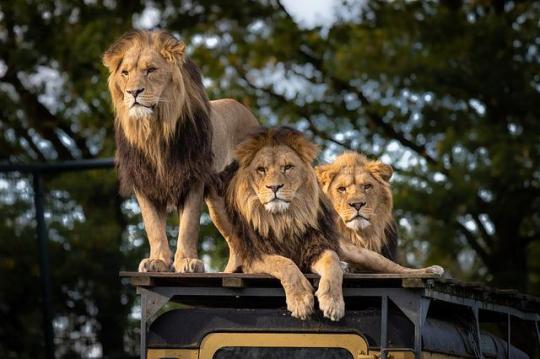
The safari ride drives you through the African plains to Wild Asia, spotting zebras, lions, buffalos, and more.
Longleat Safari park
Longleat Safari Park, located in Wiltshire, unarguably hits the top list of the best safaris in the UK. The park is divided into various sections where you can drive in your own car or book a VIP experience to enjoy the jeep ride, feed the animals, and more.
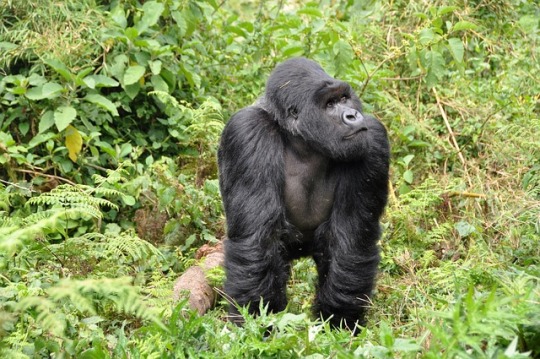
The major attractions of the Longleat Safari Park are the famous Elizabethan House-an adventure castle, a hedge maze, and the magnificent gorilla colony.
All these safari parks in the UK are waiting to be explored. So, visit these parks for the best safari experience.
0 notes
Photo

Black Lechwe
13 notes
·
View notes
Text
hunting
Website: https://www.squawmountainranch.com/
Address: 2576 Squaw Mountain Rd, Jacksboro, TX 76458
Phone: +1 (830) 275-3277
Today, SMR is offering some of the best Texas Trophy Whitetail Hunting and Exotic Hunting opportunities in all of Texas, along with Bird, Turkey, Hog, Varmint, and More Hunts including: Trophy Elk, Axis Deer, Scimitar Oryx, Blackbuck Antelope, Fallow Deer, Addax, Aoudad, Buffalo, White Buffalo, Corsican Rams, Black Hawaiian, Bongo, Blesbok, Catalina Goats, Eland, Four-Horned Sheep, Gazelle, Gemsbok, Himalayan Tahr, Impala, Hybrid Ibex, Kudu, Markhor, Mouflon Ram, Nyala, Nubian Ibex, Red Stag, Red Lechwe, Sable, Spanish Goats, Springbok, Texas Dall Ram, Transcaspian Urial, Wildebeest, Zebra and other African game to the discriminating hunter.
Located in Jack County, less than 2 hours from the Dallas/Fort Worth Metroplex, Squaw Mountain Ranch offers premier Big Texas Whitetail Hunting Operation providing an experience of a lifetime to all hunters.

1 note
·
View note
Text
the signs as animals
arist: south african cheetah
aries: american black bear
argo: kordofan giraffe
arga: griffon vulture
arittanius: wildebeest
arittarius: yak
arpio: bowhead whale
arpia: african elephant
arlo: horse
aro: barn owl
ara: tiger
arza: white rhinoceros
aricorn: spider monkey
ariborn: ring-tailed lemur
arnius: tabby cat
arius: megabat
asci: rock dove
asces: pied crow
armino: lion
armini: eurasian wolf
arcer: gerbil
arcen: newt
arus: bush-tailed porcupine
arun: philippine forest rat
taurrist: asiatic cheetah
taurries: asian black bear
taurgo: nubian giraffe
taurga: cinereous vulture
taurittanius: roan
taurittarius: southern marsupial mole
taurpio: right whale
taurpia: asian elephant
taurlo: sea eagle
tauro: grass owl
taurra: sheep
taurza: sumatran rhinoceros
tauricorn: vervet monkey
tauriborn: aye-aye
taurnius: jungle cat
taurrius: flying fox
taursci: trocaz pigeon
taursces: american crow
taurmino: kit fox
taurmini: tundra wolf
taurcer: guinea pig
taurcen: seal
taurus: crested porcupine
taurun: nile rat
gemrist: north american cougar
gemries: atlas bear
gemgo: west african giraffe
gemga: white-rumped vulture
gemittanius: waterbuck
gemittarius: northern marsupial mole
gempio: blue whale
gempia: blue-ringed octopus
gemlo: snake-eagle
gemo: sooty owl
gemra: argali
gemza: black rhinoceros
gemicorn: proboscis monkey
gemiborn: sifaka
gemnius: european wildcat
gemrius: egyptian fruit bat
gemsci: laurel pigeon
gemsces: cape crow
gemmino: red fox
gemini: arabian wolf
gemcer: dove
gemcen: house mouse
gemus: long-tailed porcupine
gemun: moluccan prehensile-tailed rat
canrist: florida panther
canries: blue bear
cango: reticulated giraffe
canga: black vulture
canittanius: eland
canittarius: golden mole
canpio: bryde’s whale
canpia: dumbo octopus
canlo: black-chested buzzard-eagle
cano: itombwe owl
canra: mouflon
canza: indian rhinoceros
canicorn: pygmy marmoset
caniborn: mouse lemur
canius: black-footed cat
canrius: california leaf-nosed bat
cansci: hill pigeon
cansces: hooded crow
canmino: cape fox
canmini: steppe wolf
cancer: humming bird
cancen: mayor’s moue
canus: bristle-spined rat
canun: bulldog rat
lerist: african leopard
leries: eurasian brown bear
lego: angolan giraffe
lega: turkey vulture
leittanius: gerenuk
leittarius: eurasian beaver
lepio: fin whale
lepia: mimic octopus
lelo: black solitary eagle
leo: bay owl
lera: urial
leza: nile hippopotamus
leicorn: rhesus macaque
leiborn: cockatiel
lenius: sand cat
lerius: hondurian white bat
lesci: snow pigeon
lesces: somali crow
lemino: arctic fox
lemini: mongolian wolf
lecer: flying squirrel
lecen: sikkim mouse
leus: prehensile-tailed porcupine
leun: kerala rat
virrist: javan leopard
virries: eurasian brown bear
virgo: south african giraffe
virga: california condor
virittanius: steenbok
virittarius: north american beaver
virpio: see whale
virpia: blanket octopus
virlo: crested eagle
viro: scops owl
virra: bighorn sheep
virza: east african hippopotamus
viricorn: gibbon
viriborn: parrotlet
virnius: chinese mountain cat
virrius: big brown cat
virsci: specled pigeon
virsces: flores crow
virmino: fennec fox
virmini: dingo
vircer: unstriped ground squirrel
vircen: volcano mouse
virus: electric eel
virun: himilayan field rat
librist: northern goshawk
libries: grizzly bear
libgo: masai giraffe
libga: greater flamingo
libittanius: nyala
libittarius: star-nosed mole
lipio: chilean dolphin
lipia: coconut octopus
liblo: harpy eagle
libo: screech owl
libra: thinhorn sheep
libza: cape hippopotamus
libicorn: bornean orangutan
libiborn: caique
libnius: amazon weasel
librius: dwarf epaulettes fruit bat
libsci: wood pigeon
libsces: bismark crow
limino: grey fox
limini: dog
libcer: indian palm squirrel
libcen: indian field mouse
libus: hog-nosed skunk
libun: sunburned rat
scorrist: gray-bellied hawk
scorries: east siberian brown bear
scorgo: thornicroft’s giraffe
scorga: lesser flamingo
scorittanius: klipspringer
scorittarius: hairy-tailed mole
scorpio: arabian dolphin
scorpia: giant squid
scorlo: papuan eagle
scoro: snowy owl
scorra: snow sheep
scorza: west african hippopotamus
scoricorn: sumatran orangutan
scoriborn: lorikeet
scornius: mountain weasel
scorrius: split-nosed bat
scorsci: comoros olive pigeon
scorsces: white-necked crow
scormino: swift fox
scormini: tibetan wolf
scorcer: eastern grey squirrel
scorcen: ryukyu mouse
scorus: hooded skunk
scorun: aceh rat
sagirist: red-chested goshawk
sagiries: syrian brown bear
sagigo: pig
sagiga: chilean flamingo
sagiittanius: kudu
sagiittarius: eastern mole
sagipio: long-beaked dolphin
sagipia: colossal squid
sagilo: balck eagle
sagio: great horned owl
sagira: red kangaroo
sagiza: angola hippopotamus
sagiicorn: tapanuli orangutan
sagiiborn: parakeet
saginius: steppe polecat
sagirius: brown long-eared bat
sagisci: white-naped pigeon
sagisces: jungle crow
sagimino: plains bison
sagimini: japanese wolf
sagicer: colorado chipmunk
sagicen: cook’s mouse
sagius: striped skunk
sagiun: snake
capririst: besra
capriries: giant panda
caprigo: chicken
capriga: jame’s flamingo
capriittanius: lechwe
capriittarius: gansu mole
capripio: killer whale
capripia: humboldt squid
caprilo: spotted eagle
caprio: eagle owl
caprira: eastern grey kangaroo
capriza: north american ostrich
capriicorn: eastern gorilla
capriiborn: pianos parrot
caprinius: long-tailed weasel
capririus: mediterranean horseshoe bat
caprisci: stork
caprisces: fish crow
caprimino: wood bison
caprimini: indian wolf
capricer: grey-collard chipmun
capricen: cypriot mouse
caprius: spotted skunk
capriun: spider
aquarist: long-tailed hawk
aquaries: sloth bear
aquago: red junglefowl
aquaga: andean flamingo
aquittanius: springbok
aquittarius: long-tailed mole
aquapio: pilot whale
aquapia: japanese flying squid
aqualo: tawny eagle
aquo: fish owl
aquara: western grey kangaroo
aquaza: masai ostrich
aquicorn: western gorilla
aquiborn: cockatoo
aquanius: yellow-bellied weasel
aquarius: raccoon
aquasci: goose
aquasces: house crow
aquamino: european bison
aquamini: arctic wolf
aquacer: gray-footed chipmunk
aquacen: steppe mouse
aqus: fattail scorpion
aqun: alligator
pirist: chanting goshawk
piries: polar bear
pigo: cow
piga: american flamingo
piittanius: sable antelope
piittarius: japanese shrew mole
pipio: houglass dolphin
pipia: vampire squid
pilo: camel
pio: spotted wood owl
pira: antilopine kangaroo
piza: arabian ostrich
piicorn: chimpanzee
piiborn: conure
pinius: european mink
pirius: koalas
pisci: duck
pisces: palm crow
pimino: water buffalo
pimini: baffin island wolf
picer: uinta chipmunk
picen: meerkat
pius: pandinus
piun: crocodile
#homestuck#zodiac#extended zodiac#the signs as#long post#originality is overrated#i spent way way way way too long on this thing
671 notes
·
View notes
Photo

Trophy hunting South Africa
Get the most comprehensive packages of 8 Days Hunting and 7 Trophy hunting South Africa. Nick Bowker is a professional hunting outfitter who organizes various trophy hunting packages that includes hunting CapeBuffalo, Waterbuck, Blesbock, Impala, Eland, eastern Cape Kudu, Nyala, Warthog, Springbok, Gemsbok, Zebra, Red Lechwe, Black Wildebeest, Mountain Reedbuck, Red Hartebeest, Bushbuck, Fallow Deer, and more. Get to know all the Hunting packages. Reach out to Nick Bowker Hunting to plan the exciting trophy hunting tour packages now.
0 notes
Text
A Wild Dog's Tale

First shown on the National Geographic Channel, this nature documentary retells the story of Solo, a lonely African wild dog that has befriended a number of jackals and hyenas in the fertile heart of Botswana's Okavango Delta, a place teeming with game but also predators. Once there were plenty of wild hounds living here. Solo was part of a larger pack that used to terrorise the floodplains around camp - impala, red lechwe and kudu were all easy prey to their speed and agility. Solo's pack was sadly reduced to three when they were caught in an ambush set by lions and most of the surviving dogs left the area, with only three deciding to stay, two males and a female. Shortly after this, the trio was reduced to one: Solo. Local guides were unsure if the other two had been killed or simply moved off in search of their pack members, but Solo was not leaving, she was staying put, left all single to fend for herself in a hostile world. For first six months, Solo wandered the park hunting by herself, avoiding the scary carnivores which would kill her given half a chance
Wild dogs are team players, born to run with the pack, but now Solo was all by herself. She eventually gave up calling for her missing mates, and observers assumed she would wander away in search of new ones. But instead, Solo settled on the island of Mombo and started behaving in a very surprising way. She made friends with a pair of young spotted hyenas. As if this was not unusual enough, Solo began associating with several families of black-backed jackals. It seems her instinctive desire to be part of a pack was driving her behaviour. She started taking it upon herself to share her kills with the local jackals and, even more so, their offspring. This phenomenal interaction was caught on camera and documented by Brad Bestelink.
It may appear improbable for a wild dog to form such a close bond with hyenas and jackals, but this relationship works well and brings benefits to each of them. Solo is a superb hunter and being alone, had the advantage of not having other dogs break cover and alert the prey. But now, instead of hunting with a pack of dogs, Solo is accompanied on her hunts by her motley pack of hyenas and jackals. Her friends get a reliable supply of food courtesy of Solo. They in turn help warn Solo of approaching lions that would otherwise try to kill her. So close is Solo to her hyena friends that when she comes into oestrous she even presents herself to them for mating.
But it is Solo's relationship with the jackals that is most surprising. Over the last few years, Solo has helped the jackals raise their pups, frequently regurgitating food to them just as she would her own pups. At first the adult jackals were wary of this strange interloper and tried to chase Solo off by biting and attacking her. But once she started feeding the pups, the jackals accepted her. Now Solo often spends the day resting close together with the jackals and the pups have grown extremely close to her. Spending so much time with the jackals has its benefits, for Solo's favourite food, impala, do not seem to recognize the danger as long as she is among her jackal friends. Often the impala venture unwittingly close, making it easier for Solo to catch them.
Further to her relationship with the jackals, in which she eventually connected with at least four known parent couples, was her interaction with hyena. The hyena would tolerate her and even greet her in the late afternoons at the local airstrip before watching her set off on her hunt. They would lope as close behind as they could, knowing that she would be successful, and that they would be able get a meal to themselves. It is amazing to see her "adopt" the baby jackals and how she and the parents are able to live and work together to raise all the pups. She hunts for them and protects them from her prior hyena friends, who begin to stalk them. Her maternal instinct is enormous, and she continues to survive with her surrogate families. Solo can teach us important lessons about tolerance and perseverance and inner strength. This is a wonderful movie to watch with your children.
0 notes
Photo
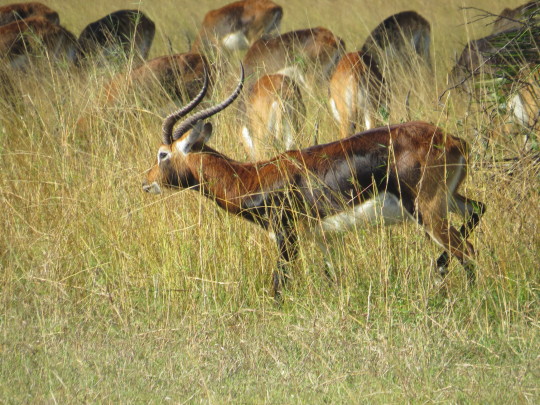
Black lechwe Kobus smithemani
Observed by dougmacsafaris, CC-BY-NC
2 notes
·
View notes
Text
Name: Citizen Kyra Pherigo
Color: Deep Wine #2c041c
Symbol: defaced broken spade
Strife Specibus: forkkind
Handle: exhaustedGallimaufry
Animal: lechwe
Pronouns: he/him
Age: 15
Birthday: 126th day of the year
Sexuality: indecipherable
Interests: winemaking and vegetable farming
Dream Moon: derse
Classpect: Witch of Breath
Land: Land of Forest and Sound, an exuberant place, with fantastic Shield-tailed snake consorts. It is a place full of geysers of lymph and a black desert. Echidna lurks at it's core.
Instrument: pianette
via homestuck-human-generator https://ift.tt/3scaDvQ
0 notes
Text
Five Reasons Why You Should Go On a Zambia Safari

If you're looking to get as close as possible to Africa's flora and fauna, then Zambia - the home of walking safaris - is the ideal destination for you. Boasting the thundering Victoria Falls - one of the Seven Natural Wonders of the World - Zambia is a wildlife-rich destination hosting more water than any other African country due to its wealth of rivers, lakes and waterfalls. If you need some Zambia safari inspiration, here are five reasons why you should visit this landlocked African country.
The Victoria Falls

Also known as Mosi-oa-Tunya, what means ‘The Smoke that Thunders’, Victoria Falls is the only waterfall in the world with a length of more than a kilometre and a height of more than hundred meters. A UNESCO World Heritage Site, the Victoria Falls is so loud that it's falling curtain of water can be heard up to 40 kilometres away.
Kasanka Bat Migration
Every October the world’s largest migration of giant fruit bats happens at Kasanka National Park. Eight million fruit bats will harmlessly pass your head as they dance in the sky. To see more rare species, the southern floodplains of Lake Bangweulu are famous for large herds of the near-endemic black lechwe.
The Zambezi River
Definitely worth a visit during your safari in Zambia is the Zambezi River. The Lower Zambezi River basin in the Southern Province is excellent for bush camping, fishing for tigerfish, boat cruises and other excursions like canoeing along with crocodiles, hippos and thirsty elephants. For more fishing and boat trips you can spend a weekend on the largest artificial lake, Lake Kariba, also situated in the Southern Province.
20 National Parks
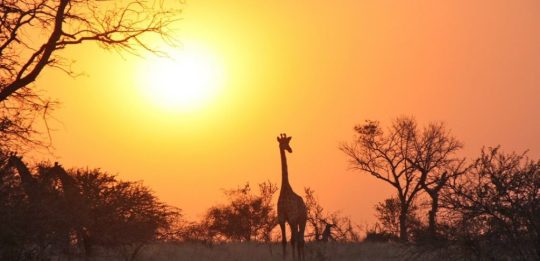
There are 20 national parks and 34 game management areas in Zambia, leaving you spoilt for choice of options to enjoy a thrilling wildlife safari. South Luangwa National Park is the most popular choice as it offers fantastic daytime and nighttime game drives. At the end of November, the Liuwa Plains National Park is worth a visit, where at the end of November you can see the world’s second-largest wildebeest migration. In Kafue National Park, you can see lions swimming in swamps and climbing sycamore trees.
https://www.drivesouthafrica.com/blog/five-reasons-why-you-should-go-on-a-zambia-safari/
0 notes
Text
Black Lechwe Hunting in South Africa: What You Need to Know

In this article, I will be discussing the black lechwe hunting, a species that is not only difficult to hunt but also elusive.
Where Does The Black Lechwe Live?
The black lechwe is native to the floodplains of southern Africa, in countries such as Angola, Botswana, Namibia, Zambia, and Zimbabwe. It is typically found in wetlands and marshes, as well as in tall grasslands and riverbanks.
How Many Different Species Of Black Lechwe Exist?
Black Lechwe are a type of antelope native to the wetlands of Southern Africa, and there are four different species of them. The Nile Lechwe (Kobus megaceros) is the most widespread type, living in the wetlands of Zambia, Angola, Namibia, Botswana and Zimbabwe.
The Red Lechwe (Kobus leche) is found in Zambia's Kafue Flats and in the Bangweulu wetlands of Tanzania. The Upemba Lechwe (Kobus anselli) is found in the Upemba wetlands of the Democratic Republic of Congo, while the Lichtenstein's Lechwe (Kobus lictensteinii) is found in Angola and Zambia.
All four species are classified as vulnerable by the International Union for Conservation of Nature and Natural Resources (IUCN), primarily due to habitat loss caused by human activity. For example, the Upemba Lechwe population has decreased drastically due to unsustainable fishing and agricultural practices. To protect these species, conservation efforts such as wetland protection, habitat restoration and reforestation are needed to help safeguard their future.
Why Is It So Difficult To Hunt The Black Lechwe?

Hunting the Black Lechwe can be quite a challenge. This majestic antelope species is native to the wetlands of Sub-Saharan Africa, and tracking them requires a lot of skill and expertise. The terrain in which they live is often marshy and slippery, making it especially difficult for inexperienced hunters. Additionally, the Black Lechwe is a very skittish species, so it can be hard to get close enough to get a good shot.
For these reasons, it is important for hunters to have the right gear, knowledge of the terrain, and patience when attempting to hunt the Black Lechwe. Having the right equipment and understanding of the environment is key to having a successful hunting experience.
It's also important to stay still and take your time when stalking the Black Lechwe; any movement could scare them off. Understanding how these animals behave and where they are most likely to be found is also an important factor in successful hunting trips. With the right preparation and knowledge, hunting the Black Lechwe can be a thrilling and rewarding experience.
How Can I Prepare For My Hunt For The Black Lechwe?
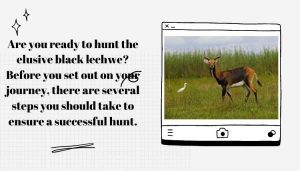
Are you ready to hunt the elusive black lechwe? Before you set out on your journey, there are several steps you should take to ensure a successful hunt.
- First, you'll need to obtain the necessary licenses and permits for hunting the black lechwe.
- Second, research the species to better understand its behavior and habitat. This will help you narrow down your search and increase your chances of success.
- Third, make sure your gear is in good condition and that you have plenty of supplies for your trip. Invest in quality binoculars and scopes to spot the lechwe from a distance.
- Fourth, scout the area beforehand to identify potential spots to hunt.
- Lastly, bring along a hunting companion to help spot the animal and provide extra safety. By following these steps, you'll be well prepared for your hunt for the black lechwe.
What Equipment Do I Need For My Hunt For The Black Lechwe Hunting?
When embarking on a hunt for the black lechwe, there is a wide range of equipment that you will need to ensure a successful and safe hunt.
- Firstly, you should bring appropriate clothing for the terrain and weather conditions. This includes water-resistant hiking boots, insulated clothing, and a wide-brimmed hat.
- Secondly, you will need to invest in the right optics to make sure that you can spot the black lechwe in the landscape. Binoculars and a spotting scope are essential for this job. Additionally, you should also bring along a rangefinder to accurately measure the distance between you and the animal.
- Thirdly, it is important that you bring the correct firearms for hunting. A high-powered rifle is typically recommended for this kind of hunt. You should also include ammunition and a cleaning kit for your gun.
- Lastly, you will need to bring along other items such as a first-aid kit, compass, knife, and insect repellent. By taking these items with you on your hunt, you can make sure that you have an enjoyable and successful trip searching for the black lechwe.
How Do I Hunt The Black Lechwe?
Hunting the Black Lechwe is an exciting and thrilling experience for many hunters. To successfully hunt this animal, you will need to be well-prepared and familiar with the terrain.
To ensure a successful hunt, it is important to have the right clothing and gear. You should wear camouflage, waterproof clothing, and good quality boots. Additionally, you will need a good quality rifle and ammunition. A hunting knife and a net can also be useful.
Furthermore, it is important to be aware of the animal's behavior and know where to find them. During the summer months, Black Lechwe can be found in wetland areas such as marshes and ponds. When hunting, you should move slowly and carefully through wetlands to avoid spooking any animals away. You should also consider the wind direction when hunting and use cover to remain hidden from the animal's view.
Lastly, it is important to obtain a hunting license from your local wildlife department before beginning your hunt. With the right preparation and knowledge, you can have a successful hunt for the Black Lechwe.
Conclusion
While the black lechwe is not an easy animal to hunt, there are ways that you can prepare for your expedition and succeed. With some preparation and perseverance, you can bag yourself a trophy black lechwe
- Fascinating Facts About the Black Lechwe Antelope
Referans: Black Lechwe Hunting
Frequently asked Questions
What Are the Best Hunting Conditions for Black Lechwe?The best hunting conditions for black lechwe are during the dry season from November to March, when the animals are most active and vulnerable.What Tips Should I Follow When Hunting Black Lechwe?There are a few tips that you should follow when hunting black lechwe, including tracking them using dogs, wearing camouflage clothing and using night vision goggles.What Equipment Do I Need To Hunt Black Lechwe?For black lechwe hunting, you will need a good pair of binoculars, a firearm, ammunition, trail dressing and bait.Where Can I Hunt Black Lechwe?The best places to hunt black lechwe in South Africa are in Limpopo, Mpumalanga and North West provinces.
Read the full article
0 notes
